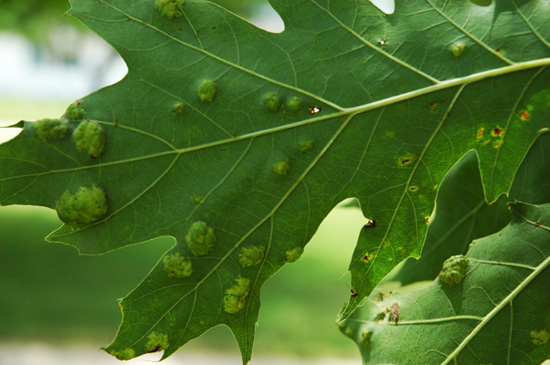Issue 6, May 29, 2009
Oak Leaf Blisters
Here is a fungal disease that you may be seeing soon on your oak leaves. The causal fungus is Taphrina caerulescens. Although many oaks may be attacked, red oak is most susceptible. Leaf blisters (aka leaf curl) refers to a group of diseases on oak and occasionally on poplar. Leaf distortion and blister-like growths or puckering of the leaves is common to all. The leaves are often thickened. At first the puckered areas are green but these turn red and then brown as the season progresses. The image shows the disease on a red oak in the author's yard in spring.

The causal fungus survives over winter in buds and on twigs. They infect leaves and flowers in the cool, moist weather of early spring, from bud swell to bud opening (ideally temperatures are 50 to 70 degrees F). Obviously, 2009 has been ideal for Taphrina infection.
Oak leaf blisters is an aesthetic problem on mature trees. I do not treat my oak tree and would not recommend others treating their oaks. A related disease occurs on fruit. It is caused by other Taphrina species and causes enough damage to warrant treatment. That disease is called peach leaf curls. The fungus that causes oak blisters does not cause peach leaf curls. For more on peach leaf curls, visit http://web.aces.uiuc.edu/vista/pdf_pubs/805.pdf (Adobe PDF).
Landscape managers should focus on promoting oak tree health through pruning, watering, and fertilization. Fungicides are not usually recommended for ornamental trees unless the disease is a chronic problem on very young trees. Regardless, it is too late to spray fungicides to fight this disease for 2009. If you are having problems with curl and blisters, mark your calendar for a late fall or winter fungicide application so you don't forget again.
If you have used sprays to control Taphrina but have not obtained control of the disease, consider these facts. Sprays must provide complete coverage of the stems and buds. The fungus over winters in bud scales and cracks and crevices of the bark, so thorough coverage is necessary. Check Illinois pest management manuals to be certain you have chosen the correct fungicide. Chemicals must be applied in the dormant season, which means either late fall or early spring before buds swell. Fungicides for homeowners are listed in the Home, Yard, and Garden Pest Guide. Fungicides available to commercial growers are listed in the Commercial Landscape and Turfgrass Pest Management Handbook.--Nancy Pataky
Author:
Nancy Pataky